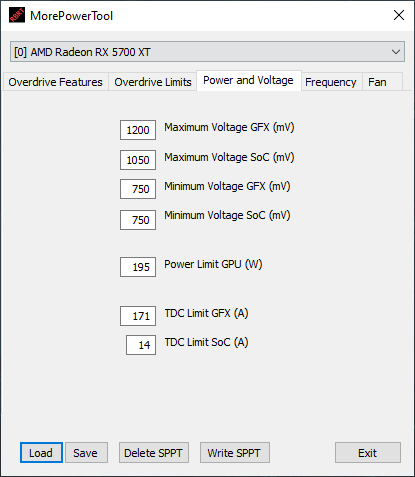Because not everyone might be familiar with what softmodding means, here a good definition: a softmod is a method of using software to modify the intended behavior of hardware, such as video cards, sound cards, or game consoles in a way that can overcome restrictions of the firmware or install custom firmware.
https://books.google.com/books?id=g5YC6-sPS5gC&lpg=PA50&dq=Forensic%20Investigation%20of%20the%20Soft-Modded%20PlayStation%20Portable%20(PSP)&pg=PA50#v=onepage&q=Forensic%20Investigation%20of%20the%20Soft-Modded%20PlayStation%20Portable%20(PSP)&f=false
Igorslab discovered where in the Windows-registry certain AMD-values for the 5700 XT are stored and how to modify it to get the desired values, the softpowerplay tables. This began because there is a need to clock the 5700 GPU higher, because those can clock higher than the maximum which AMD allows and give better performance. To make it easier Igorslab also developed the MorePowerTool: https://www.igorslab.media/morepowertool-amd-radeon-rx-5700-und-rx-5700-xt-tweaking-and-overclocking-software/
For the 5700 XT aftermarket-cards a new useful application has arisen. Some of the companies (ASUS is the worst offender) use overly agressive values: 1200 mV for the VSOC, 200A for the maximum current, 210W for the TDP, a 1940’ish MHz for the GPU with the so-called quiet BIOS. Here a screenshot of the default voltages and currents on the ASUS Strix 5700 XT:
If there is interest I will also show all the other values.
That the values are overly agressive is not just an opinion. Here the voltages and currents for the Sapphire Nitro 5700 XT:

This comes from Igorslab their review of the Sapphire Nitro. Here another useful article on their website: https://www.igorslab.media/en/making-the-radeon-rx-5700-and-rx-5700-xt-more-energy-efficient-and-significantly-quieter-with-the-morepowertool-tutorial/
They have done more reviews of 5700 (XT) cards and for their more recent reviews they show all the values, making it easy to compare.
It is known that the Nitro and the Strix have the same performance for games but because of these horrible default values the Strix has a much higher power draw resulting in considerably more noise while the cooling of the card is good. On Windows it is easy to fix this but that doesn’t do any good if you would like to game on Linux. I try to be environmentally responsible to some extend so this gets in the way of playing most games on Linux. Other than that I also believe that you shouldnt clock this higher than 1860-1900 MHz because there is a bad scaling between power consumption and FPS but this is a more subjective issue.
As I understand it it works on Windows like this. When you first plug in the graphics card and install the drivers then the data from the BIOS is read and based on this somehow in the registry certain values are stored for certain keys and other software (AMD-driver, AMD Settings, Afterburner…) determines based on these values what to do.
My question is straightforward, how can I accomplish the same on Linux as when I use the MorePowerTool on Windows? Where in the Linux file tree are these values stored? How (just editing a text file or also running some commands) do I change these values?
PS
If a moderator thinks that this topic is more suitable for another category then feel free to move it to there. Don’t blame me for the 720p-resolution of the first picture, that is due to Microsoft Paint refusing to store it at my monitor-resolution.





